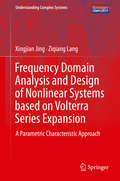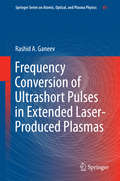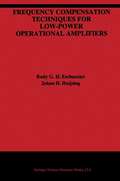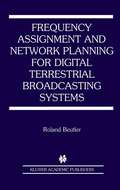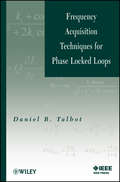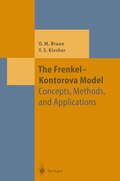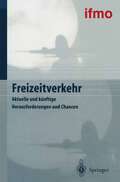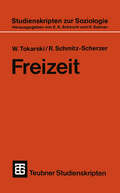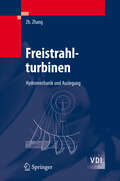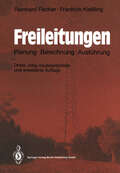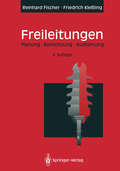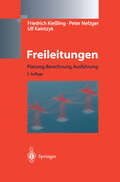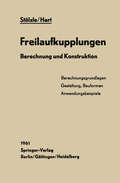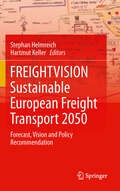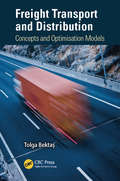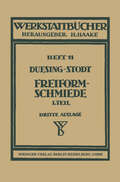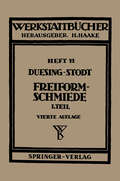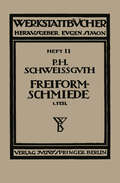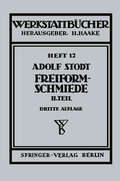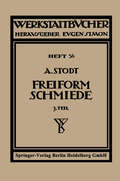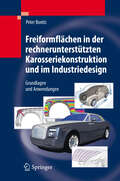- Table View
- List View
Frequency Domain Analysis and Design of Nonlinear Systems based on Volterra Series Expansion: A Parametric Characteristic Approach (Understanding Complex Systems)
by Xingjian Jing Ziqiang LangThis book is a systematic summary of some new advances in the area of nonlinear analysis and design in the frequency domain, focusing on the application oriented theory and methods based on the GFRF concept, which is mainly done by the author in the past 8 years. The main results are formulated uniformly with a parametric characteristic approach, which provides a convenient and novel insight into nonlinear influence on system output response in terms of characteristic parameters and thus facilitate nonlinear analysis and design in the frequency domain. The book starts with a brief introduction to the background of nonlinear analysis in the frequency domain, followed by recursive algorithms for computation of GFRFs for different parametric models, and nonlinear output frequency properties. Thereafter the parametric characteristic analysis method is introduced, which leads to the new understanding and formulation of the GFRFs, and nonlinear characteristic output spectrum (nCOS) and the nCOS based analysis and design method. Based on the parametric characteristic approach, nonlinear influence in the frequency domain can be investigated with a novel insight, i.e., alternating series, which is followed by some application results in vibration control. Magnitude bounds of frequency response functions of nonlinear systems can also be studied with a parametric characteristic approach, which result in novel parametric convergence criteria for any given parametric nonlinear model whose input-output relationship allows a convergent Volterra series expansion. This book targets those readers who are working in the areas related to nonlinear analysis and design, nonlinear signal processing, nonlinear system identification, nonlinear vibration control, and so on. It particularly serves as a good reference for those who are studying frequency domain methods for nonlinear systems.
Frequency Conversion of Ultrashort Pulses in Extended Laser-Produced Plasmas (Springer Series on Atomic, Optical, and Plasma Physics #89)
by Rashid A GaneevThis book offers a review of the use of extended ablation plasmas as nonlinear media for HHG of high-order harmonic generation (HHG). The book describes the different experimental approaches, shows the advantages and limitations regarding HHG efficiency and discusses the particular processes that take place at longer interaction lengths, including propagation and quasi-phase matching effects. It describes the most recent approaches to harmonic generation in the extreme ultraviolet (XUV) range with the use of extended plasma plumes, and how these differ from more commonly-used gas-jet sources. The main focus is on studies using extended plasmas, but some new findings from HHG experiments in narrow plasma plumes are also discussed. It also describes how quasi-phase-matching in modulated plasmas, as demonstrated in recent studies, has revealed different means of tuning enhanced harmonic groups in the XUV region. After an introduction to the fundamental theoretical and experimental aspects of HHG, a review of the most important results of HHG in narrow plasmas is presented, including recent studies of small-sized plasma plumes as emitters of high-order harmonics. In Chapter 2, various findings in the application of extended plasmas for harmonic generation are analyzed. One of the most important applications of extended plasmas, the quasi-phase-matching of generated harmonics, is demonstrated in Chapter 3, including various approaches to the modification of perforated plasma plumes. Chapter 4 depicts the nonlinear optical features of extended plasmas produced on the surfaces of different non-metal materials. Chapter 5 is dedicated to the analysis of new opportunities for extended plasma induced HHG. The advantages of the application of long plasma plumes for HHG, such as resonance enhancement and double-pulse method, are discussed in Chapter 6. Finally, a summary section brings together all of these findings and discuss the perspectives of extended plasma formations for efficient HHG and nonlinear optical plasma spectroscopy. The book will be useful for students and scholars working in this highly multidisciplinary domain involving material science, nonlinear optics and laser spectroscopy. It brings the new researcher to the very frontier of the physics of the interaction between laser and extended plasma; for the expert it will serve as an essential guide and indicate directions for future research.
Frequency Compensation Techniques for Low-Power Operational Amplifiers (The Springer International Series in Engineering and Computer Science #313)
by Rudy G.H. Eschauzier Johan HuijsingFrequency Compensation Techniques for Low-Power Operational Amplifiers is intended for professional designers of integrated amplifiers, emphasizing low-voltage and low-power solutions. The book bridges the gap between the professional designer's needs and available techniques for frequency compensation. It does so by explaining existing techniques and introducing several new techniques including Hybrid Nested Miller compensation, Multipath Miller Zero cancellation and Multipath Conditionally Stable compensation. All compensation techniques are treated in a stage-number-based order, progressing from a single transistor to circuits with six stages and more. Apart from discussing the mathematical basis of the compensation methods, the book provides the reader with the factual information that is required for practicing the design of integrated feedback amplifiers and many worked out examples. What is more, many bipolar and CMOS operational amplifier realizations, along with their measurement results, prove the effectiveness of the compensation techniques in real-life circuits. The text focuses on low-voltage, low-power integrated amplifiers. Many of the presented bipolar circuits operate at supply voltages down to 1V, while several CMOS amplifiers that function correctly just slightly above this voltage are demonstrated. The lowest measured power consumption amounts to 17muW for a class AB CMOS opAmp with 120dB gain. Despite this attention to low voltage and low power, the frequency compensation strategies provided are universally applicable. The fundamental approach followed leads to efficient compensation strategies that are well guarded against the parameter variations inherent to the mass-fabrication of integrated circuits. The book is essential reading for practicing analog design engineers and researchers in the field. It is also suitable as a text for an advanced course on the subject.
Frequency Assignment and Network Planning for Digital Terrestrial Broadcasting Systems (Ercoftac Ser.)
by Roland BeutlerFrequency Assignment and Network Planning for Digital Terrestrial Broadcasting Systems focuses on Digital Audio Broadcasting and Digital Video Broadcasting. The author provides a concise introduction to the subject and presents principles, concepts and commonly accepted methods used in the planning process. The frequency assignment material focuses on allotment planning while network planning is dealt with mainly from a network optimization perspective. All methods introduced and mathematical tools presented are fully explained. General concepts are illustrated with the help of several planning scenarios both for frequency assignment and network planning. Frequency assignment and network planning are vital issues throughout most of Europe and North America as a direct consequence of the increasing demand for digital communication systems.
Frequency Acquisition Techniques for Phase Locked Loops (Ieee Series On Digital And Mobile Communication Ser.)
by Daniel B. TalbotHow to acquire the input frequency from an unlocked state A phase locked loop (PLL) by itself cannot become useful until it has acquired the applied signal's frequency. Often, a PLL will never reach frequency acquisition (capture) without explicit assistive circuits. Curiously, few books on PLLs treat the topic of frequency acquisition in any depth or detail. Frequency Acquisition Techniques for Phase Locked Loops offers a no-nonsense treatment that is equally useful for engineers, technicians, and managers. Since mathematical rigor for its own sake can degenerate into intellectual "rigor mortis," the author introduces readers to the basics and delivers useful information with clear language and minimal mathematics. With most of the approaches having been developed through years of experience, this completely practical guide explores methods for achieving the locked state in a variety of conditions as it examines: Performance limitations of phase/frequency detector–based phase locked loops The quadricorrelator method for both continuous and sampled modes Sawtooth ramp-and-sample phase detector and how its waveform contains frequency error information that can be extracted The benefits of a self-sweeping, self-extinguishing topology Sweep methods using quadrature mixer-based lock detection The use of digital implementations versus analog Frequency Acquisition Techniques for Phase Locked Loops is an important resource for RF/microwave engineers, in particular, circuit designers; practicing electronics engineers involved in frequency synthesis, phase locked loops, carrier or clock recovery loops, radio-frequency integrated circuit design, and aerospace electronics; and managers wanting to understand the technology of phase locked loops and frequency acquisition assistance techniques or jitter attenuating loops. Errata can be found by visiting the Book Support Site at: http://booksupport.wiley.com
Frequency Acquisition Techniques for Phase Locked Loops
by Daniel B. TalbotHow to acquire the input frequency from an unlocked state A phase locked loop (PLL) by itself cannot become useful until it has acquired the applied signal's frequency. Often, a PLL will never reach frequency acquisition (capture) without explicit assistive circuits. Curiously, few books on PLLs treat the topic of frequency acquisition in any depth or detail. Frequency Acquisition Techniques for Phase Locked Loops offers a no-nonsense treatment that is equally useful for engineers, technicians, and managers. Since mathematical rigor for its own sake can degenerate into intellectual "rigor mortis," the author introduces readers to the basics and delivers useful information with clear language and minimal mathematics. With most of the approaches having been developed through years of experience, this completely practical guide explores methods for achieving the locked state in a variety of conditions as it examines: Performance limitations of phase/frequency detector–based phase locked loops The quadricorrelator method for both continuous and sampled modes Sawtooth ramp-and-sample phase detector and how its waveform contains frequency error information that can be extracted The benefits of a self-sweeping, self-extinguishing topology Sweep methods using quadrature mixer-based lock detection The use of digital implementations versus analog Frequency Acquisition Techniques for Phase Locked Loops is an important resource for RF/microwave engineers, in particular, circuit designers; practicing electronics engineers involved in frequency synthesis, phase locked loops, carrier or clock recovery loops, radio-frequency integrated circuit design, and aerospace electronics; and managers wanting to understand the technology of phase locked loops and frequency acquisition assistance techniques or jitter attenuating loops. Errata can be found by visiting the Book Support Site at: http://booksupport.wiley.com
The Frenkel-Kontorova Model: Concepts, Methods, and Applications (Theoretical and Mathematical Physics)
by Oleg M. Braun Yuri S. KivsharAn overview of the basic concepts, methods and applications of nonlinear low-dimensional solid state physics based on the Frenkel--Kontorova model and its generalizations. The book covers many important topics such as the nonlinear dynamics of discrete systems, the dynamics of solitons and their interaction, commensurate and incommensurate systems, statistical mechanics of nonlinear systems, and nonequilibrium dynamics of interacting many-body systems.
French Urbanism in Foreign Lands
by Ambe J. NjohThis book will seek to close the gaps on the role of France in exporting Eurocentric spatial and environmental design principles and practice. It does so by analyzing the major spatial and physical development projects that French colonial authorities implemented in France’s colonial empire and elsewhere from the 15th to the 20th century. French urban planning ideology, principles and practice were not exported exclusively to territories under French colonial suzerainty. Accordingly, the book focuses on major physical and spatial planning schemes inspired by French planning thought in territories without a history of French colonialism.
Freizeitverkehr: Aktuelle und künftige Herausforderungen und Chancen (Mobilitätsverhalten in der Freizeit)
by Institut Für Mobilitätsforschung Institut IfmoFreizeitverkehr weist seit längerem unvermindert steigende Zuwachsraten auf. Alle Prognosen deuten darauf hin, daß dies auch in Zukunft so bleiben wird. Allerdings kann man unbegrenztes Wachstum in einem Umfeld begrenzten Raumes und begrenzter Ressourcen nicht sich selbst überlassen. Bevor aber der Gesellschaft durch ordnungspolitische Interventionen, Einschränkungen und Begrenzungen auferlegt werden müssen, sollten alle Gestaltungsmöglichkeiten ausgeschöpft werden. Im Rahmen einer Konferenz mit Experten aus Politik, Wissenschaft und Wirtschaft wurden sowohl die gegenwärtige Situation als auch künftige Herausforderungen und mögliche Strategien diskutiert. Dieses Buch enthält die wesentlichen Beiträge, Ergebnisse und Schlußfolgerungen.
Freitragende Holzbauten
by F. Geißler Th. Gesteschi W. Greim O. Hetzer A. Jackson O. Kaper H. Lewe S. Michalski A. Nenning R. Plönnis J. Stamer H. Storck S. Voss Kersten WeißDieser Buchtitel ist Teil des Digitalisierungsprojekts Springer Book Archives mit Publikationen, die seit den Anfängen des Verlags von 1842 erschienen sind. Der Verlag stellt mit diesem Archiv Quellen für die historische wie auch die disziplingeschichtliche Forschung zur Verfügung, die jeweils im historischen Kontext betrachtet werden müssen. Dieser Titel erschien in der Zeit vor 1945 und wird daher in seiner zeittypischen politisch-ideologischen Ausrichtung vom Verlag nicht beworben.
Freistrahlturbinen: Hydromechanik und Auslegung (VDI-Buch)
by Zhengji ZhangDer Autor gibt aus ingenieurwissenschaftlicher Sicht einen Überblick über die wesentlichen Erkenntnisse der Hydromechanik von Freistrahlturbinen. Die Strömungsprozesse und alle relevanten hydromechanischen Aspekte werden möglichst vollständig und systematisch beschrieben. Sämtliche Verluste, inklusive der hydraulischen Reibungseffekte, werden behandelt und quantifiziert. Das Nachschlagewerk richtet sich an Ingenieure, Turbinenhersteller, Kraftwerksbetreiber und Interessierte aus Lehre und Forschung im Fachbereich „Strömungsmaschinen".
Freileitungen: Planung, Berechnung, Ausführung
by Reinhard Fischer Friedrich KießlingBei Freileitungen hat sich in den letzten Jahren ein vielfältiger Wandel vollzogen, der bisher in der Literatur noch nicht zusammenfassend dokumentiert ist. So wurden die einschlägigen Normen und Vorschriften völlig neu gestaltet und die SI-Einheiten eingeführt. Die Möglichkeiten der Datenverarbeitung haben sich erweitert und können zunehmend für die Optimierung genutzt werden. Bei Lastannahmen für Tragwerke, bei Leiterschwingungen, bei der Ausführung der Leiter, der Armaturen und der Isolatoren liegen neue Erkenntnisse vor, neue Bauformen wurden geschaffen. Die Methoden der Montage haben sich ebenso gewandelt. Der Einfluß der Umwelt auf die Gestaltung von Freileitungen hat zugenommen. Ziel des Buches ist, die dem heutigen Stand der verfügbaren Hilfsmittel entsprechenden Planungs- und Berechnungsmethoden darzustellen, die weiterführende Literatur aufzulisten und die Leitungsbaupraxis mit besonderer Berücksichtigung der Bundesrepublik Deutschland zu schildern. Von der vorherigen Auflage unterscheidet es sich durch eine völlige Neubearbeitung und Neugestaltung des Textes mit Rücksicht auf neuere Erkenntnisse und neuere Literatur, durch erweiterten Inhalt und verbesserte Darstellung sowie das Eingehen auf die gewandelte Leitungsbaupraxis.
Freileitungen: Planung, Berechnung, Ausführung
by F. Kießling P. Nefzger U. KaintzykDie Globalisierung des Elektroenergiemarktes führte zur europäischen Norm EN 50341-1 und der daraus abgeleiteten Festlegung für Deutschland EN 50341-3-4. Diese Normen erschienen erst im Jahre 2001. Das Buch stellt die Planung von Freileitungen, die Auswahl der Leiter, die Berechnung und Ausführung der Masten und Gründungen sowie aller anderen Bauteile und die neueren Montagemethoden dar. Es greift auf die aktuellen Ausgaben der einschlägigen nationalen und internationalen Vorschriften zurück und gibt einen Überblick über die wichtige Literatur. Das Werk kann als Nachschlagewerk dienen und als Dokumentation für den derzeitigen technischen Standard des Leitungsbaus. Es wendet sich an Studierende, Berufsanfänger bei Betreibern, Herstellern und Beratungsfirmen, sowie an alle in der Elektrizitätswirtschaft Tätigen.
Freilaufkupplungen: Berechnung und Konstruktion (Konstruktionsbücher #19)
by Karl Stölzle Sigwalt HartFREIGHTVISION - Sustainable European Freight Transport 2050: Forecast, Vision and Policy Recommendation
by Stephan Helmreich and Hartmut KellerThis book has been written on the basis of the research done between 2008 and 2010 as part of the European Commission funded FREIGHTVISION project. The “FREIGHTVISION - Freight Transport 2050 Foresight” project was funded by the Directorate General MOVE to design a long term vision for European freight transport in 2050 and to identify actions and research to progress appropriate freight transport measures in Europe. The project was carried out as a foresight process encompassing four conferences in which the project team identified and developed with the aid of more than 100 experts an action plan for securing long term freight transport in Europe. The book provides insights into the freight transport visions and Backcasts identified for 2035 and 2050, issues which need to be addressed and measures which were assessed to be part of future paths to assure an economical, environmental, and social freight transport system.
Freight Transport and Distribution: Concepts and Optimisation Models
by Tolga BektasThis book serves as a primer on freight transportation and logistics, providing a general and broad coverage of concepts, mathematical models and methodologies available for freight transportation planning at strategic, tactical and operational levels. It is aimed at graduate students, and is also a reference book for practitioners in the field.The book includes preliminaries, such as mathematical modeling and optimisation algorithms. The book also features case studies and practical real-life examples to illustrate applications of the concepts and models covered, and to encourage a hands-on and a practical approach. The author has taught and published extensively in the field and draw on state-of-the-art scientific research. He has also been part of a number of practical research projects, which underpin the real life examples in the book.
Freight Transport and Distribution: Concepts and Optimisation Models
by Tolga BektasThis book serves as a primer on freight transportation and logistics, providing a general and broad coverage of concepts, mathematical models and methodologies available for freight transportation planning at strategic, tactical and operational levels. It is aimed at graduate students, and is also a reference book for practitioners in the field.The book includes preliminaries, such as mathematical modeling and optimisation algorithms. The book also features case studies and practical real-life examples to illustrate applications of the concepts and models covered, and to encourage a hands-on and a practical approach. The author has taught and published extensively in the field and draw on state-of-the-art scientific research. He has also been part of a number of practical research projects, which underpin the real life examples in the book.
Freiformschmiede: Teil 1: Grundlagen, Werkstoff der Schmiede, Technologie des Schmiedens (Werkstattbücher #11)
by F. W. Duesing A. StodtDieser Buchtitel ist Teil des Digitalisierungsprojekts Springer Book Archives mit Publikationen, die seit den Anfängen des Verlags von 1842 erschienen sind. Der Verlag stellt mit diesem Archiv Quellen für die historische wie auch die disziplingeschichtliche Forschung zur Verfügung, die jeweils im historischen Kontext betrachtet werden müssen. Dieser Titel erschien in der Zeit vor 1945 und wird daher in seiner zeittypischen politisch-ideologischen Ausrichtung vom Verlag nicht beworben.
Freiformschmiede: Erster Teil: Grundlagen, Werkstoffe der Schmiede Technologie des Schmiedens (Werkstattbücher #11)
by F.W. Duesing A. StodtFreiformschmiede: Erster Teil: Technologie des Schmiedens Rohstoff der Schmiede (Werkstattbücher #11)
by Paul H. SchweißguthDieser Buchtitel ist Teil des Digitalisierungsprojekts Springer Book Archives mit Publikationen, die seit den Anfängen des Verlags von 1842 erschienen sind. Der Verlag stellt mit diesem Archiv Quellen für die historische wie auch die disziplingeschichtliche Forschung zur Verfügung, die jeweils im historischen Kontext betrachtet werden müssen. Dieser Titel erschien in der Zeit vor 1945 und wird daher in seiner zeittypischen politisch-ideologischen Ausrichtung vom Verlag nicht beworben.
Freiformschmiede: Zweiter Teil Konstruktion und Ausführung von Schmiedestücken (Schmiedebeispiele) (Werkstattbücher #12)
by A. StodtFreiformschmiede: Dritter Teil: Einrichtung und Werkzeuge der Schmiede (Werkstattbücher #56)
by A. Stodt Adolf StodtDieser Buchtitel ist Teil des Digitalisierungsprojekts Springer Book Archives mit Publikationen, die seit den Anfängen des Verlags von 1842 erschienen sind. Der Verlag stellt mit diesem Archiv Quellen für die historische wie auch die disziplingeschichtliche Forschung zur Verfügung, die jeweils im historischen Kontext betrachtet werden müssen. Dieser Titel erschien in der Zeit vor 1945 und wird daher in seiner zeittypischen politisch-ideologischen Ausrichtung vom Verlag nicht beworben.
Freiformflächen in der rechnerunterstützten Karosseriekonstruktion und im Industriedesign: Grundlagen und Anwendungen
by Peter BonitzDer Entwicklungsprozess von der Designidee bis zum Werkzeug für die Blechumformung im Karosseriebau verlangt ein solides Verständnis der CAD-Technologien. Deshalb geht der Autor weit über die Beschreibung grundlegender Fähigkeiten zur Bedienung von CAD-Systemen hinaus und vermittelt mathematische Grundlagen sowie deren Einsatz bei der Gestaltung. Das Buch wendet sich an Entwickler von CAD-Anwendungen, an Designer, Konstrukteure und Werkzeugbauer (Automotive, Maschinenbau, Luft- und Raumfahrt), die frei geformte Oberflächen gestalten.
